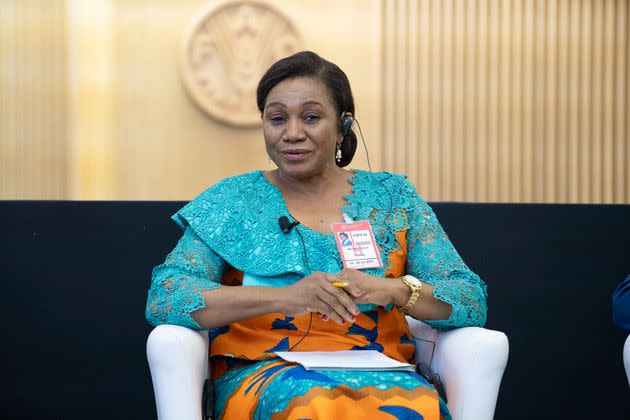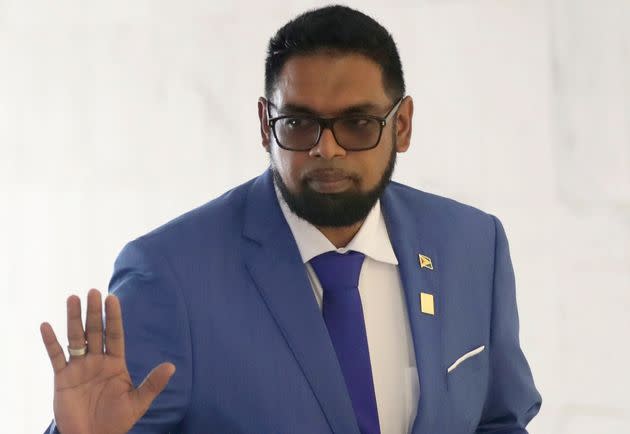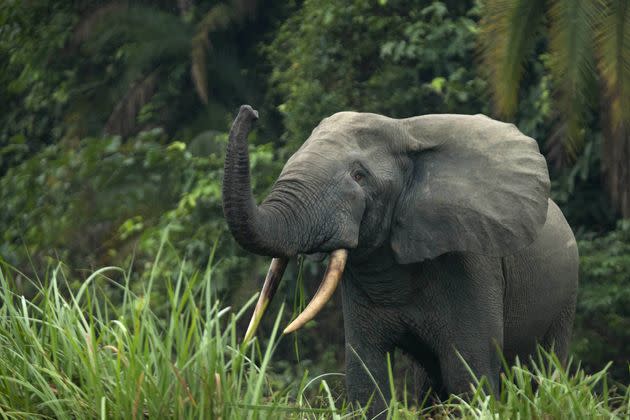This Country Produces Less Than 1% Of Emissions. Is That A Pass To Export Gas?
Lush, old-growth rainforest covers 65% of Rosalie Matondo’s country — nearly double the share of wooded land in the United States or European Union — and conservationists hail it for its success in cracking down on deforestation and poaching.
But the Republic of the Congo’s gains are in danger, Matondo warns, if the majority of Central African nation’s 6 million residents keep getting poorer. The poverty rate eclipsed 66% last year, and it’s on pace to surpass 72% next year.
As the top government official in charge of the forest economy, Matondo’s job is to find ways to make money without chopping down one of the world’s last intact old-growth rainforests. In the meantime, however, Congo is following the same path the U.S. has long taken to make money and strengthen alliances: selling natural gas to the Europeans.
Congo — sometimes called Congo-Brazzaville to distinguish the coastal state from its larger neighbor, the Democratic Republic of the Congo — this year became the world’s newest exporter of liquified natural gas. And Matondo is tired of Western environmentalists lecturing her country about the toll its fossil fuel exports take on rising global temperatures.
“We have people that will come and tell us what we have to do,” Matondo, the Congolese minister of the forest economy, told HuffPost through a French translator in a wide-ranging interview last month. “NGOs from developed countries think they can tell us what we have to do.”
Congo ranks among the world’s countries most vulnerable to climate change. And although its emissions are rising, it still constitutes a tiny fraction of a percent of the global total. The country’s trees absorb about three times as much carbon dioxide from the atmosphere as its people emit.

Built by the Italian state-owned oil giant Eni, the new LNG export terminal off Congo’s Atlantic coast sent its debut shipment to Italy in February, part of a bid to seize a slice of the fuel market Russian pipelines served before the war in Ukraine prompted Europeans to turn away from the Kremlin’s fuel. A second facility set to open next year will more than quadruple how much gas Congo can sell overseas.
“We cannot be telling the population that is poor that they should do their best to preserve biodiversity,” Matondo said. “We have to see our population not being poor, so we can try to tell them, ’OK, since you’re not poor and you have the means to survive, now you can preserve the diversity.”
She’s the latest government leader from a developing country to rebuke critics in richer parts of the world who oppose developing fossil fuel reserves amid growing global demand for oil and gas.
In March, Guyana’s president, Mohamed Irfaan Ali, lashed out at a British reporter who asked about the climate risks posed by the South American country’s massive offshore oil development. Noting that Guyana has kept the vast majority of its forests intact, Irfaan Ali accused the BBC presenter Stephen Sackur of “hypocrisy” in attempting to “lecture us on climate change.”
“I’m going to lecture you on climate change. Because we have kept this forest alive that you enjoy that the world enjoys, that you don’t pay us for, that you don’t value,” Irfaan Ali said. “Guess what? We have the lowest deforestation rate in the world. And guess what? Even with the greatest exploration of oil and gas, we will still be net zero.”
Video of the exchange, which aired on the BBC’s “HARDtalk” program, went viral. Despite limited coverage of the spat in the U.S., English-language news outlets based in places like China and India promoted the clip — a sign that the Guyanese leader’s words resonated with post-colonial countries.

“This is the hypocrisy that exists in the world,” Irfaan Ali told Sackur. “The world in the last 50 years has lost 65% of the biodiversity. We have kept ours.”
Compared to the massive oil fields U.S. giants like Exxon Mobil and Chevron are developing off South America’s northeast coast, the Congo’s fossil fuel exports are small. But after years of gearing much of its economy around selling small amounts of oil and petroleum — the country even joined the OPEC oil cartel in 2018 — Brazzaville is hoping to go big on energy exports with LNG.
Oil generates roughly 50% of the energy Congolese use at home, with natural gas comprising another 33% and renewables — particularly hydroelectric dams — providing another 17%, according to 2021 data from the U.S. Energy Information Administration.
Virtually any natural gas that wasn’t used at home was either injected into crude wells to extract more oil or burned up onsite in a highly-polluting industry practice known as “flaring.” In 2022, Congo flared about 64 billion cubic feet of gas that was seen as a waste byproduct of oil drilling — roughly four times as much gas as the country intentionally produced that same year, World Bank data show.
Capturing this gas and using it as fuel, rather than just burning it off as a byproduct of oil extraction, might be less wasteful in the long-term, proponents of the country’s LNG push argue.
And since the Congolese would have likely burned the gas as waste anyway, Eni has said its project’s “zero flaring technological approach” in the country is in line with the oil giant’s plan to cut back on planet-heating emissions.
The fossil fuel industry has a poor record of actually developing the countries from which it extracts oil and gas. Corrupt officials often pocket revenues that could otherwise go toward schools, infrastructure and investments in cleaner industries, and the fuels themselves are mostly sent overseas.
“Fossil fuel development hasn’t even solved energy poverty in the African countries that have embraced it; Nigeria has the continent’s largest and oldest fossil fuel industry and yet still has the world’s lowest energy access rates,” Amy Westervelt, an American journalist who investigates the fossil fuel industry’s propaganda campaigns, wrote in a March edition of her newsletter Drilled, referring to the Guyanese president’s comments.
“Oil majors aren’t in these countries to help them, they’re there to exploit resources.”

While much of the gas extracted in the Congo will head to Europe, economist Vijaya Ramachandran said the country will still likely develop more of its own energy infrastructure as it reaps in sales revenue, so that more of the energy it produces can go to Congolese households.
She said international institutions like the World Bank, whose shareholders include some of the richest nations in the West, should finance pipelines and transmission networks in countries like the Congo to help them vault past the dirtiest phases of development faster. Instead, however, she said developed nations and groups like the World Bank “are very keen that Africa only develop wind and solar reserves.”
“The problem with that is you can’t use wind and solar for a lot of things,” said Ramachandran, who previously worked at the World Bank and now leads energy development research at the California-based Breakthrough Institute think tank.
The U.S. has heavily invested in drilling and exporting its own gas and oil, enough to leapfrog Saudi Arabia and Russia in production and neuter the effects OPEC’s supply cuts once had on global energy prices.
The American drilling industry is responsible for adding the largest portion of cumulative emissions to the atmosphere over the past 200 years. But it isn’t anywhere close to shutting down over climate concerns.
Still, Congo may have a future in green energy, too. Matondo said she would like to see her country follow the Democratic Republic of the Congo in establishing itself as a major player in the markets for the critical minerals needed to make the lithium-ion packs electric vehicles use — even if hooking those batteries up to Congo’s own shoddy energy grid remains a challenge.
Liberia offers another example Matondo said she might follow. Last year, the government in Monrovia agreed to sell 10% of the West African country’s land to a Dubai-based company looking to preserve the forests as a way to offset emissions from the United Arab Emirates’ oil and gas sales.
Describing Congo as a “welcoming country,” she said her government is open to any international partnership that delivers a “win-win” and helps Brazzaville develop the means to keep an increasingly urban Congolese population safe, fed and air conditioned as heat waves, drought and disease intensify over the coming years.

“We need our partner to go along with us so that we may have the capacity to adapt ourselves to this climate change,” Matondo said.
Cleaner technologies that offer the same abundant energy output as fossil fuels without the emissions — such as nuclear reactors, green hydrogen fuel, or next-generation geothermal power — are still years away from full-scale deployments in rich places like the U.S., let alone in counties like Congo, which have far less-developed regulatory agencies and infrastructure.
Renewables like wind and solar are growing and will likely play a major role in Congo’s electricity system, particularly as prices for turbines and panels keep falling, Ramachandran said. But even in California, where she lives, Ramachandran pointed out that the solar panels that help keep the lights on during the day are typically backed up by gas-burning plants in the evening, or on hot days when demand for air conditioning overwhelms the electricity supply on the grid.
“We need liquid fuels. We need air conditioning. The bottom line: We need a continuous source of energy for growth, poverty alleviation and development, and renewables alone cannot provide that,” Ramachandran said.
“So telling them at this moment in time … they can only use wind and solar is just terribly unfair, because no rich country is doing that. There’s nobody in the rich world existing on renewables only,” Ramachandran said. “The idea that we expect very poor countries to do that is terribly unfair and makes no sense.”
CORRECTION: An earlier version of this story mistakenly described the Democratic Republic of the Congo as landlocked when the country has a 25-mile strip of Atlantic coast.

 Yahoo News
Yahoo News 